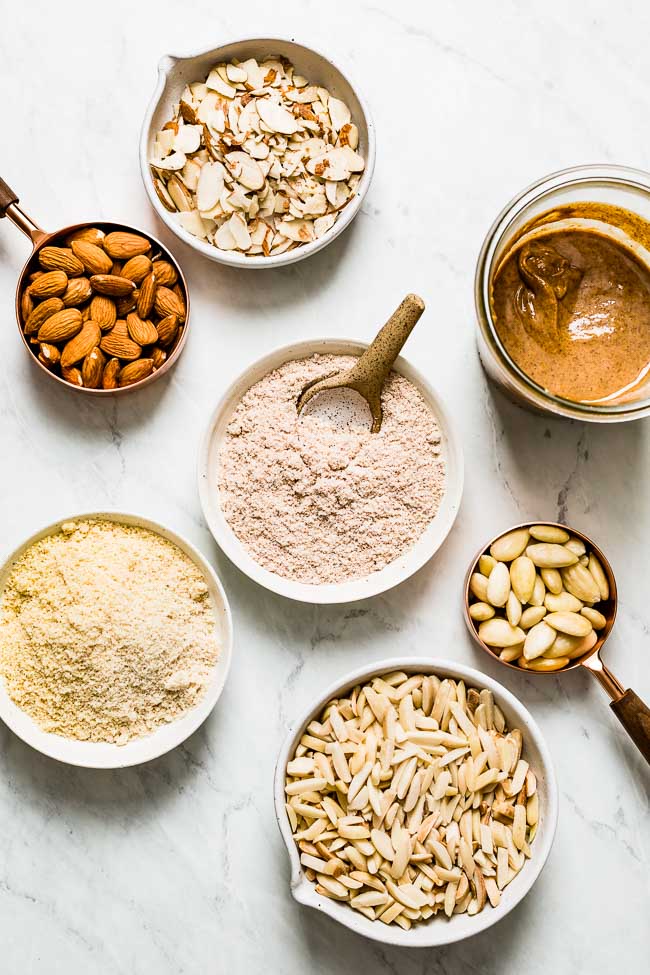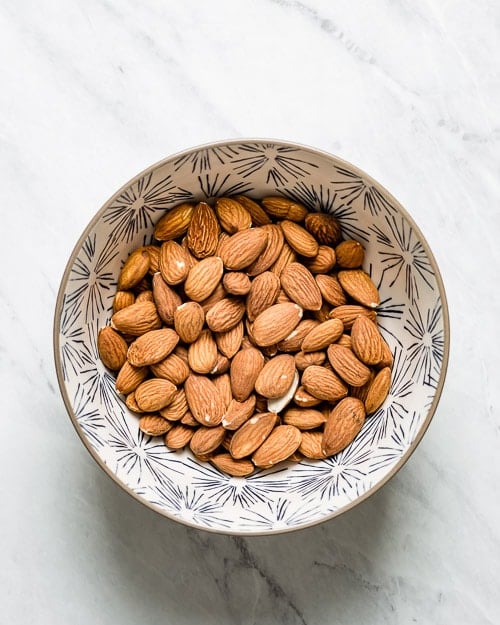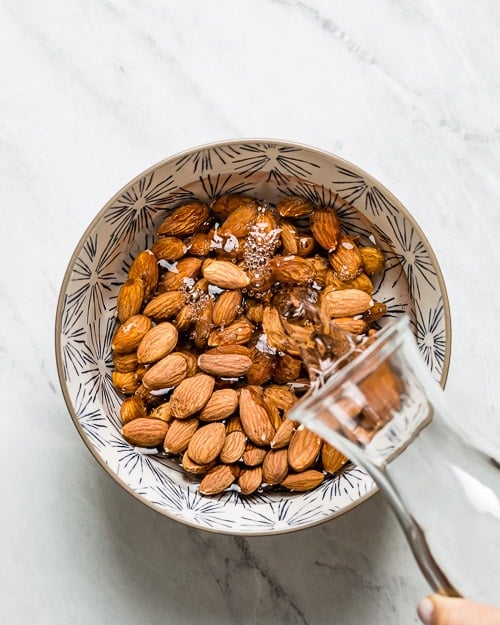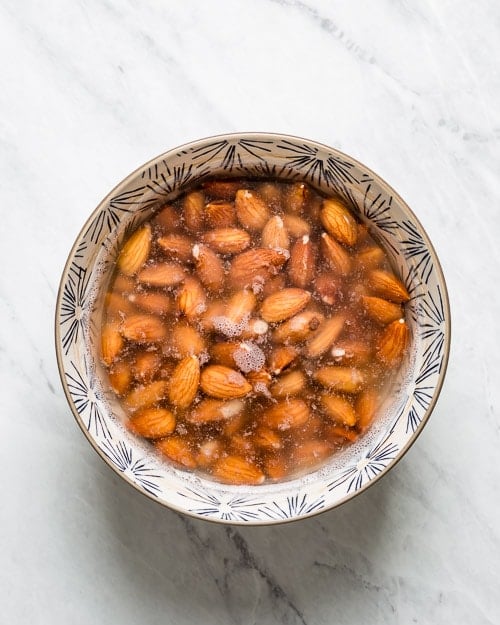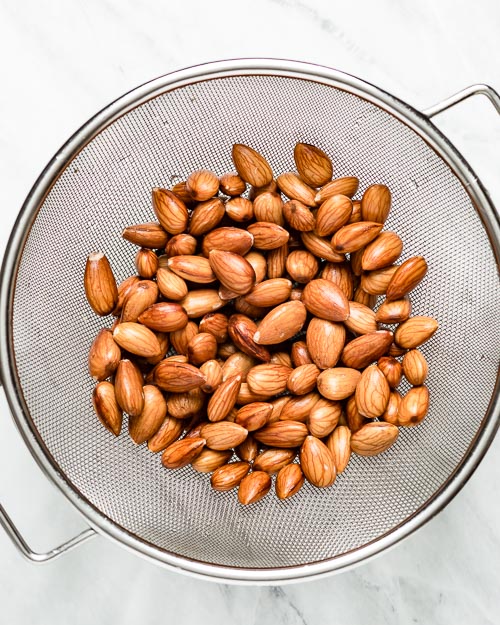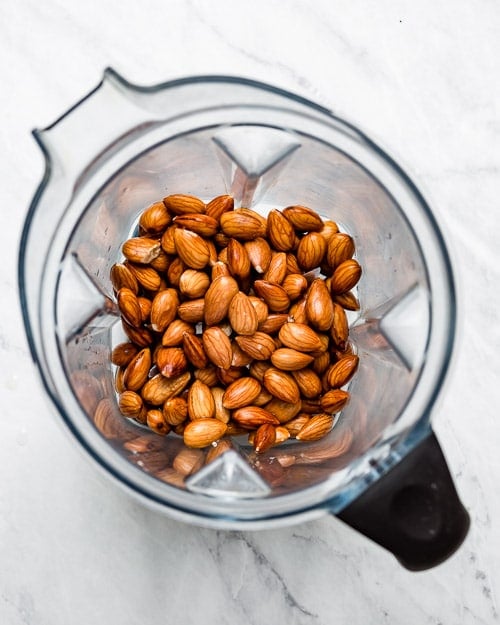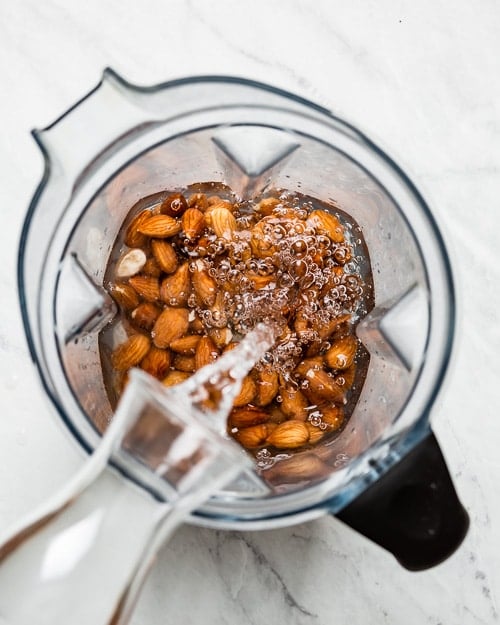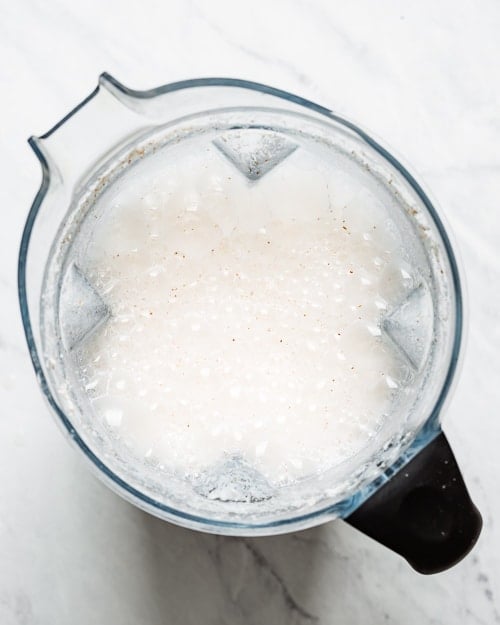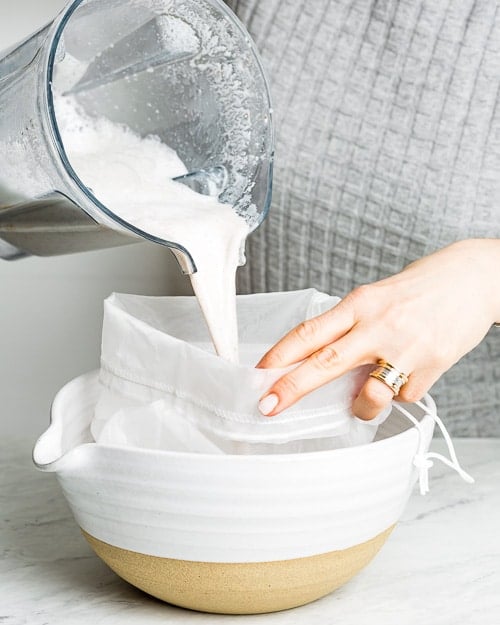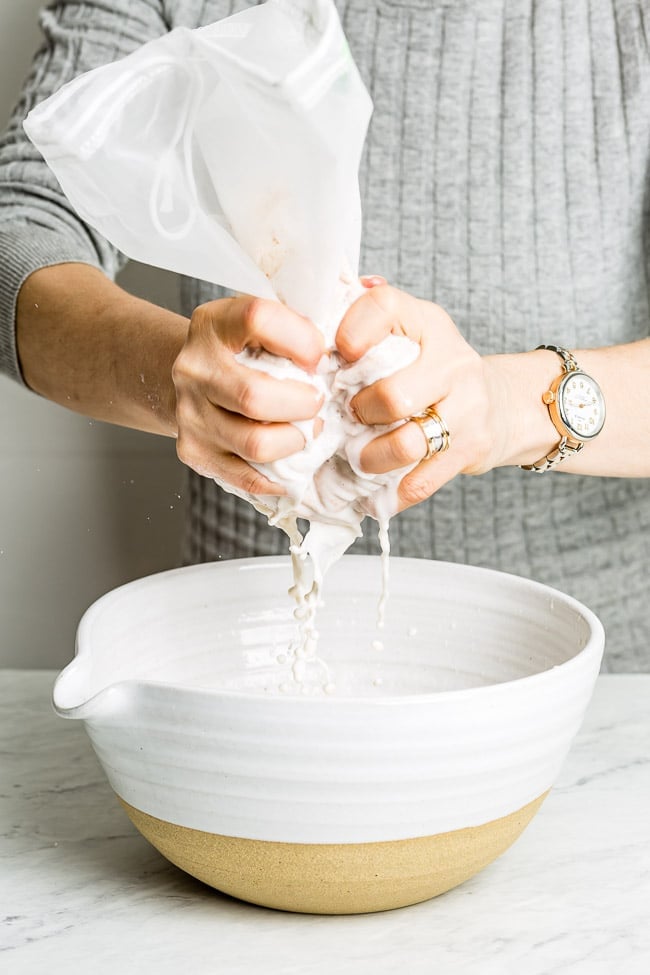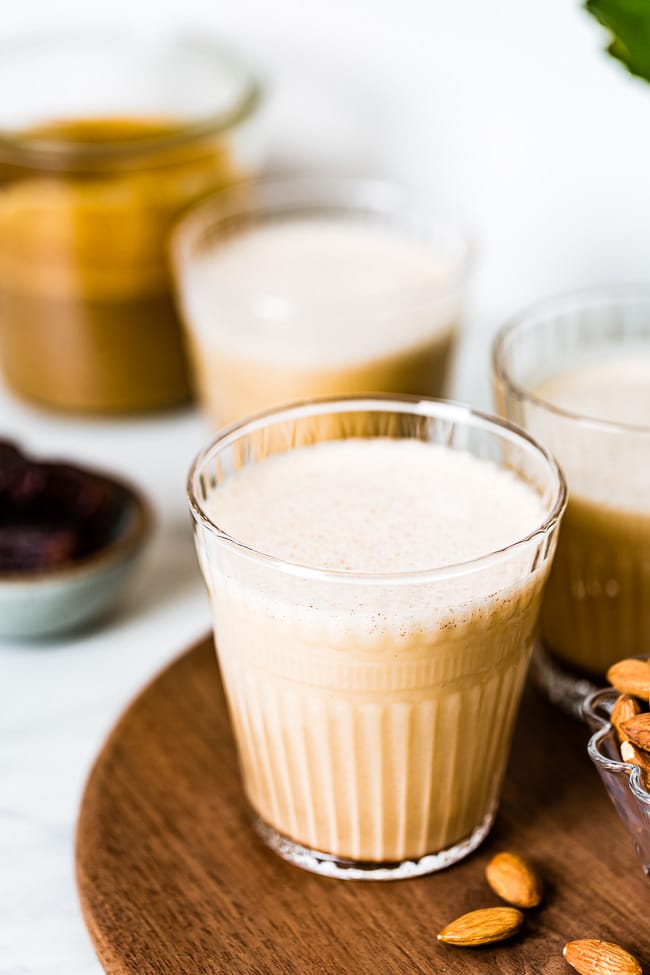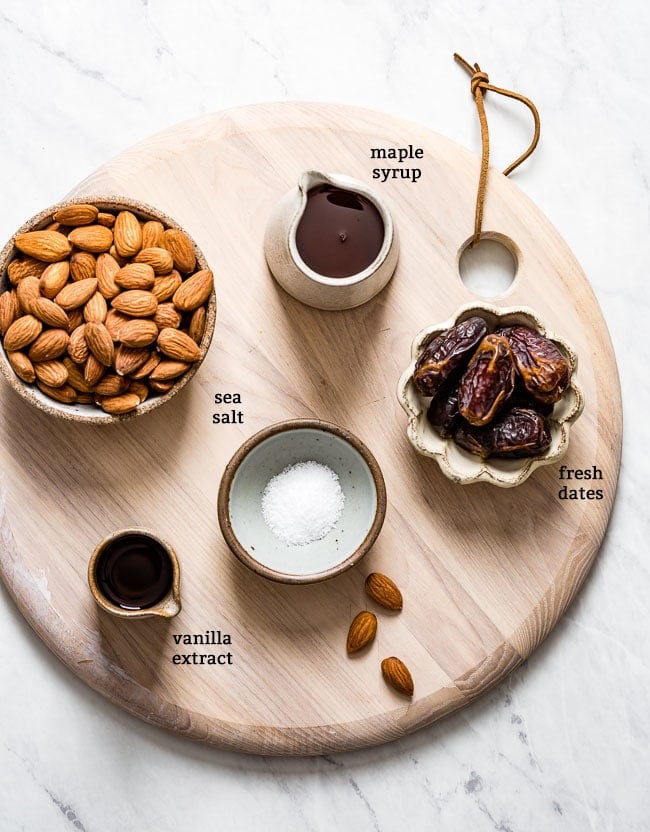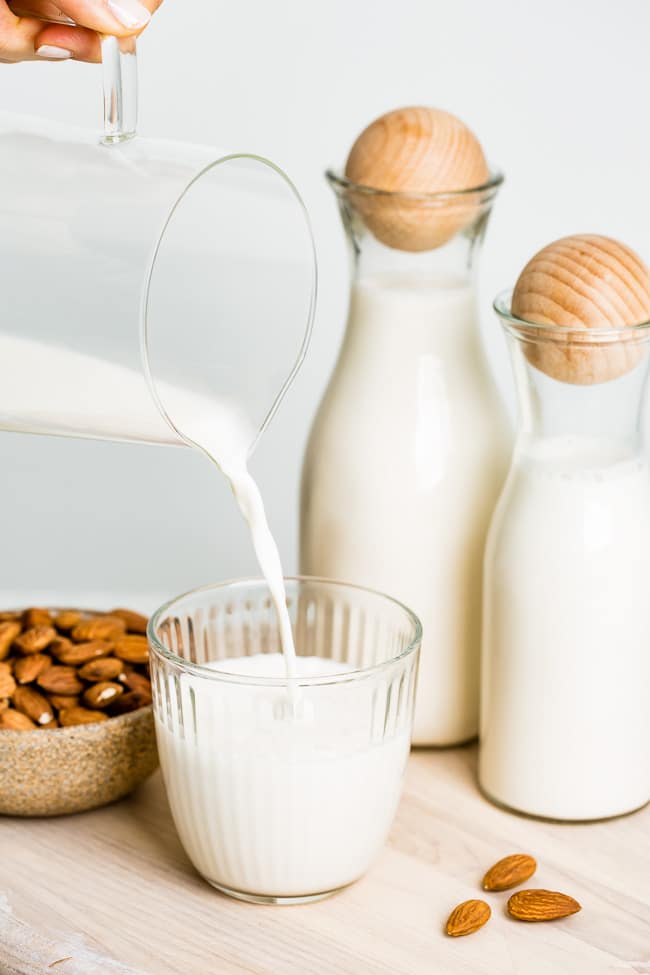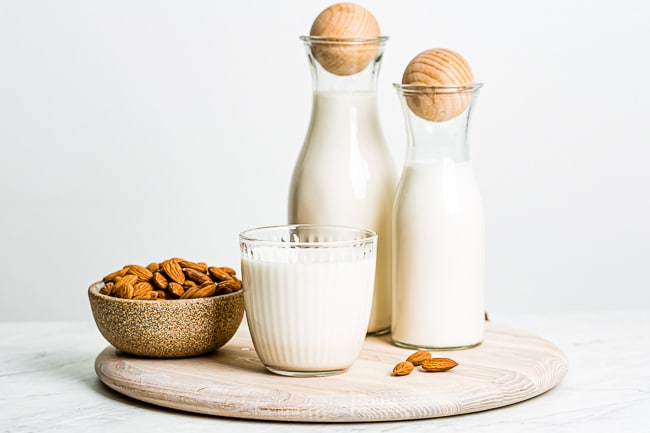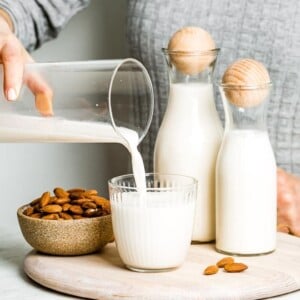I learned how to make almond milk at home after I married my lactose-intolerant husband 8 years ago. Since then I make it on a weekly basis and have learned a thing or two about making it from scratch. In this post, you will learn everything you need to know about DIY almond milk and how to incorporate it into your daily life.
Almond Milk Ingredients
The plain unsweetened homemade almond milk is made up of:
What Kind Of Almonds Should I Use
I think we can all agree that nowadays almonds come in all sizes, shapes, and forms. I thought it would be helpful to cover the types of almonds and almond products (i.e. almond flour/almond meal, almond butter, etc.) you can use to make almond your own milk.
Using Whole Raw or Blanched Almonds:
I almost always make my almond milk using raw almonds. I find that they are the best almonds for almond milk. They also are widely available and come in both unblanched or blanched. If you are not familiar, blanched almonds are almonds with the skin removed. You can easily blanch almonds at home or buy them from the store. The taste difference between almond milk made with or without the skin on is very minimal so feel free to use whichever one you have on hand. Additionally, nowadays you can also find slivered and sliced almonds in the supermarkets. These are usually used as topping in cooking and baking. You can use them to make almond milk as they are just a different cut of raw (blanched or unblanched) almonds. Just make sure that they are unsalted and unroasted.
Almond Flour & Almond Meal:
With gluten-free and paleo-friendly cooking and baking becoming so popular, nowadays most people stock almond flour and almond meal in their pantries. I personally make my almond flour at home and find that it is a cheaper alternative to store-bought almond flour. If you are short on time, using almond flour or almond meal is one of the quickest ways to make almond milk at home as it does not require soaking.
Almond Butter:
You can also use almond butter to make almond milk. This is the fastest way to make almond milk as it eliminates the need to soak almonds and doesn’t require any straining of the leftover almonds (aka almond pulp.) You can make your own almond butter at home by simply processing raw almonds in a food processor. This takes about 15-30 minutes of processing time depending on the type of food processor you own. If you are short on time, you can also buy almond butter from the store. I personally like almond butter with nothing added to it. Nowadays, most brands sell almond butter made from roasted almonds, which is fine to use in almond milk, but I personally like the variety that is made from unroasted almonds.
Soaking Almonds
If you are using raw almonds to make your almond milk, it is best to soak them for 8-12 hours. Our main goal with soaking almonds is to soften them to extract as much milk out of them as possible. In addition, according to this article on Healthline, soaking almonds has some benefits such as decreasing the levels of phytic acid levels, improving digestion, which can improve the absorption of nutrients. To soak almonds to make almond milk:
How Long Do Almonds Need to Soak:
It is best to soak almonds overnight, somewhere between 8 to 12 hours. In the end, it is likely that the water in the bowl will look cloudy with white foam over it. This is normal. Simply, place the soaked almonds in a strainer and rinse under cold water. They will look a little larger in size and softer in texture. This is also when you can easily peel them if you prefer to make your milk with blanched almonds.
How To Make Almond Milk Using Raw Almonds
The process of making almond milk is rather simple and requires only 5-10 minutes of hands-on time. Additionally, with the availability of different kinds of almonds, you can make almond milk in a few different ways. 1 cup of raw almonds weighs ~ 5.2 ounces. 1 cup of raw almonds weigh ~7.9 ounces after they are soaked in water for 12 hours As you can see they expand in size as they soak in water. Please note that the weight information I am sharing here is the result of my own testing using my own kitchen scale to provide you with helpful information. Using raw, unsalted, and unroasted whole almonds are the most popular way of making almond milk. You will need: To make it, simply place almonds in a high powered blender such as Vitamix. Pour the water over it. Start blending it at slow speed and then slowly increase it. I use 4 cups of filtered water that is 32 fluid ounces for 1 cup of raw almonds that is approximately 5.2 ounces. If you are using slivered or sliced almonds, I recommend making sure that they measure 5.2 ounces, which is equivalent to 1 cup of whole almonds. Initially, you will be able to see the almonds, but as it blends it will look like white milk. Depending on your blender, this process takes somewhere between 45 seconds to a minute.
How To Strain:
To extract the almond pulp, you can do two things:
What Happens To Almonds After Almond Milk:
If you are wondering what to do with almond pulp from making almond milk be sure to check out my guide on how to dry and use almond pulp along with ideas to use in recipes.
How To Make It Using Almond Flour or Almond Meal:
You can make almond milk with almond flour or almond milk. Doing so eliminates the soaking time so you can make almond milk in less than 10 minutes.
How To Make – Using Almond Butter:
I find that the fastest way to make almond milk is by using almond butter. I especially love it because: The process is very similar to the one made with whole almonds. Place almond flour in the bowl of your blender, pour water over and blend until smooth. Since this is my second favorite method, I shared a lengthy and detailed article/recipe about how to make almond milk using almond butter in a separate blog post.
How To Flavor:
I personally like almond milk plain and unsweetened. However, if you are in the beginning stages or prefer your milk on the sweeter side you can certainly use natural flavorings to make it taste good. Here are a few options:
Maple syrup: I recommend starting with 1 or 2 tablespoons and adjusting the amount based on your preference. Fresh dates: Be sure to add the pitted dates at the beginning of the blending process and blend well. I would start with 2 pitted dates for 1 cup of almonds & 4 cups of water. Adjust the amount according to your preference.Vanilla Extract: I use ½ teaspoon of vanilla extract just to enhance the flavors, especially if I am using my almond milk for making smoothies. On a personal note, I love vanilla almond milk so much that I can drink every day.A pinch of salt: As in all sweet recipes a pinch of salt enhances all the sweet flavors. Therefore, I recommend adding a pinch of salt if you are using sweeteners for your milk.Honey: If you don’t mind it being vegetarian you can also use honey as a sweetener. I would start with blending 1 or 2 tablespoons of honey and then adding more after giving it a taste.
How Long Does It Last:
There are many differences between commercial almond milk and its homemade version but I think the biggest difference is the shelf life. The homemade version is usually good for 3-4 days whereas, depending on the brand, store-bought milk has a longer shelf life usually up to a month. Once it is opened, it should be consumed within 7-10 days. Other notable differences between the homemade and store-bought versions:
The number of ingredients: The homemade version includes just two ingredients (and the optional flavorings) whereas the commercial version includes other ingredients such as carrageenan, gellan gum, and tricalcium phosphate. Most of the additional ingredients are used to thicken the consistency and extend its shelf life.The taste: I think when you taste-test side by side the homemade version tastes more like almonds than the commercial version.The consistency: The store-bought version has a thicker consistency compared to the homemade version. Also, I found that the homemade version is more prone to separating, which is why I recommend giving it a good shake before using it.
How To Make Homemade Almond Milk Last Longer:
For the longest time, I thought that homemade almond milk lasted no longer than 3-4 days. However, when I read Tina’s post on how to make it last longer, I decided to put her methods to use. In her post, she says that the answer to making it last longer is sanitation. In other words, you need to work super clean (and sanitized). In short, you can make it last longer by:
Blanching almonds in boiling water before soakingSoaking the almonds in the fridge in filtered waterUsing filtered water when blending and making sure that your blender is free of any residue (from pesto, soups, smoothies, etc.)Using the cheesecloth and fine mesh method and extracting the milk with the back of a spoon instead of using hands. You should also make sure everything that the ingredients touch is sanitized as well. Sterilizing bottles by rinsing them with boiling water before filling them with the milk.Storing it in the fridge and keeping it in an airtight container.
By following her steps I was able to extend the life of my homemade milk to 7 days. However, it did take a little bit more prep and work. Still, I think it is worth giving a try, especially if you are unable to consume it right away.
Can I Freeze This Plant-Based Milk
You can freeze raw almond milk. However, there are a few things you need to be aware of:
How Would I Know If It Has Gone Bad:
A few ways to detect signs of spoilage of homemade almond milk are:
Smell: This is the most obvious one. If it has gone bad then it will smell unpleasantly sour.Taste: It would have a sour taste instead of a neutral nutty tasteColor: The color would be more of a light cream color than clean white.Thicker in texture: It would look clumpy with the pulp sunk at the bottom.
What To Do With Almond Milk:
One of the questions I hear often is how to get used to almond milk. I find that one of the easiest ways to enjoy it more is by blending it into your daily meals. Here are a few things to make with almond milk:
Blend it in smoothies: Use it in smoothie recipes in place of dairy milk like I did it this Turmeric Green Smoothie and Kale Pineapple Smoothie.Turmeric Golden Milk: Use it to make golden milk using turmeric paste for a quick heartwarming drink.Almond Milk Oatmeal or Apple Cinnamon Oatmeal: Use it instead of water or dairy milk.Use it in everyday recipes like Almond Flour Pancakes or add in a splash of it to make your Overnight Steel Cut Oats or Instant Pot Steel Cut Oats even more creamy and delicious.Serve it with cereals, overnight muesli or homemade chunky granolaAdd to your morning coffee for a dairy and lactose-free creamer
Homemade Almond Milk Nutrition and Calories:
According to this article I found on Healthline, a cup of (240 ml.) unsweetened almond milk contains about 30-50 calories, while the same amount of whole dairy milk contains 146 calories. Additionally, according to the same article, it is low in calories and sugar and high in calcium, vitamin E and vitamin D. It also is vegan, dairy-free, paleo-friendly, and lactose-free.


